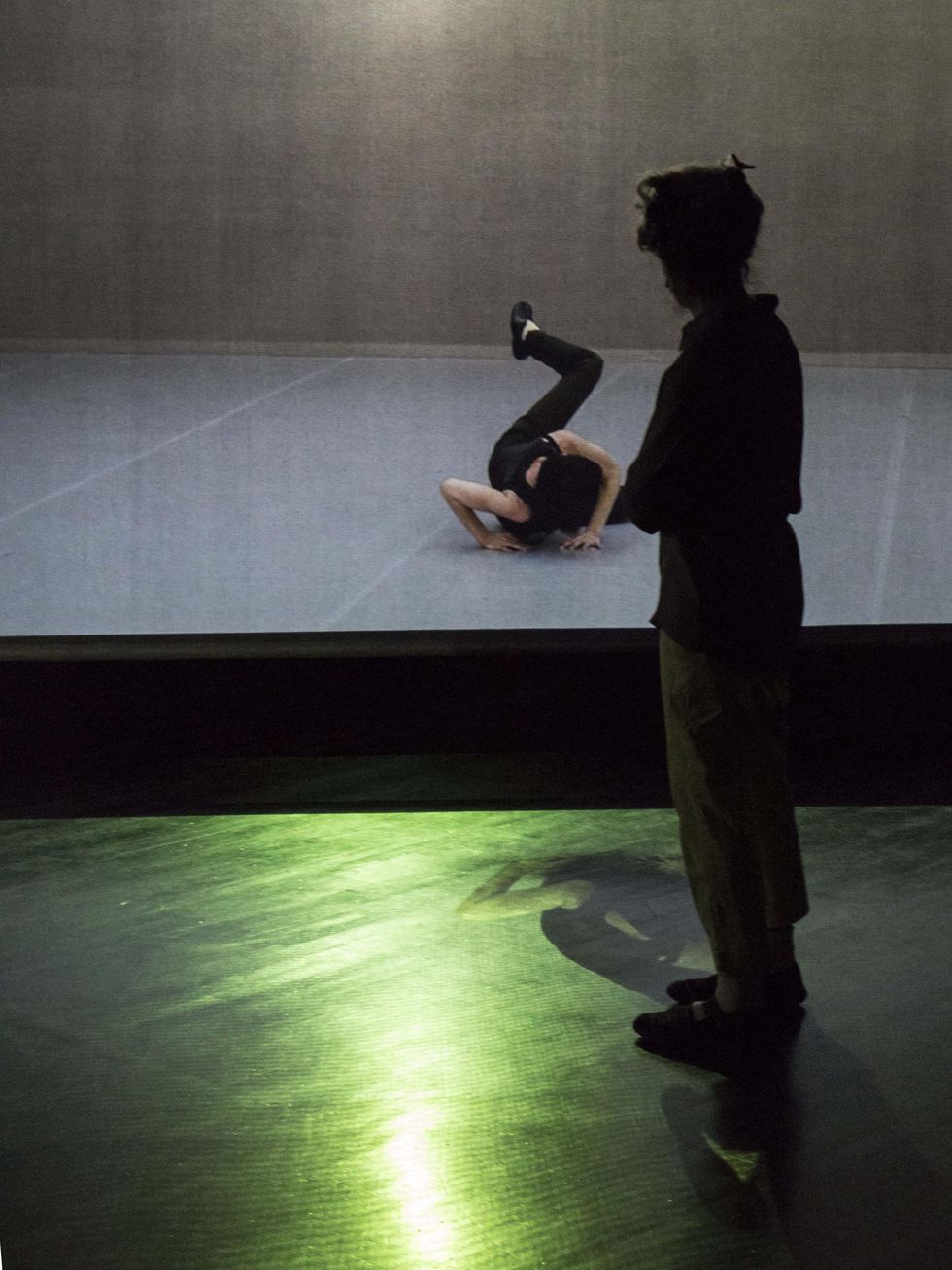Dancing at The Blanton
The Blanton's latest exhibit, Perception Unfolds, is designed to make you move
The new exhibition at the Blanton Museum of Art — Perception Unfolds: Looking at Deborah Hay’s Dance — which opened Sunday, is not entertainment, says its creator. It’s more like an experience for the viewer; not of looking at dance, but of how we perceive. “It’s a piece made for audiences, as far as I’m concerned,” Deborah Hay says in her soft but strong and gripping voice.
Hay is rarely still. When we met in mid-February to talk about Perception Unfolds she was constantly moving — adjusting her leopard hat, digging though her purse to find lens cleaner for her 1920s vintage-frame glasses, even reaching across the table at one point to examine my badly cracked iPhone, interrupting herself mid-sentence, “Look at your poor phone!”
She is a natural mover and observer, which is what you might expect from one of the most prominent and distinctive voices of the postmodern dance movement. Emerging in New York in the 1960s with the famous radical postmodern group Judson Dance Theater, Hay then spent the 1970s in a small community in Vermont reflecting on how dance is transmitted and presented, before relocating to Austin in 1976.
By walking and moving around the screens — and varying their distances — viewers see the dance from different angles.
Annette DiMeo Carlozzi, the curator of this exhibition, has the same grace and awareness about her, explaining the project with sweeping gestures that reach far out over the dark wood desk in her Blanton office. “I talk with my hands,” says Carlozzi, whose title at the Blanton is curator at large. “I’m always aware of how thinking is connected to body because I’m always actively using my body to express how I think.”
But not everyone is like that, and Hay and Carlozzi, who met when Carlozzi danced in one of Hay’s pieces in the ' 80s, know that. Their goal with Perception Unfolds is to give visitors — particularly ones who aren’t familiar with postmodern dance — an experience that challenges notions of perspective and awakens the mind/body connection that is ingrained in lifelong dancers, but not necessarily in the rest of us.
The exhibition features three huge screens with a soloist on each screen. Soloists perform individual adaptations of the same seven pieces. But, at other times, the screens turn to black or become transparent. The filmography came out of a three-year collaboration between Hay and Motion Bank, an experimental technology research project run by the German-based The Forsythe Company. When Hay saw the films, she was blown away. “I just put my foot in my own mouth,” she says of embracing the technology. “I thought, oh my god, this is fantastic. People need to see this, to get close to it.”
The exhibition is interactive. It’s designed to make you move. A score accompanies viewers as they walk through the gallery at their own pace and on their own path. By walking and moving around the screens — and varying their distances — viewers see the dance from different angles. They are able to choreograph their own experience, moving along with the dancers on screen. It’s a completely different experience from our usual perspective of passively watching dance from a seat in a theater.
Allowing viewers to engage with the dancers at such a personal level — as opposed to sitting in seats in an audience — makes it a kinetic, sensual experience. The physical engagement and unique viewer perspective is what makes this a groundbreaking exhibit. “I think that a combination of things will shed light on what the possibilities of choreography might be, how to look at dance, how to look at movement,” says Hay. “Because my movement is not traditional dance movement and so there’s really this opportunity to get to appreciate, up close, the beauty of all of it.”
It’s an unconventional exhibition, but fitting for Hay, who is consistently inventive, and, decades into her career, always moving forward. When I asked her how she continues to push limits, she responded earnestly, “It’s just all I’ve ever done, and I can’t imagine not doing it.” After taking a self-imposed sabbatical for a year — “for the first time in my life, I needed not to strive,” she says — Hay is on a roll. '
In addition to opening Perception Unfolds, she was so inspired by a piece that came out of the Motion Bank Project — 21 overlays on each other of the three dancers dancing to the seven pieces — that she thought, “I want to make a dance with 21 dancers using the timing and spacing of this,” and already has a commission from a Stockholm ballet company for the piece.
Plus, she’s wondering if Perception Unfolds might not be over after it’s Austin run, which ends May 18. “I’m really curious to see if this becomes a jumping off point for this show to travel,” she says, “And that it would originate in Austin, it would be wonderful.”
---
Perception Unfolds: Looking at Deborah Hay's Dance opened Sunday, February 23 at the Blanton at The University of Texas, Austin. More information on the exhibit can be found through The Blanton website, here. More information on Deborah Hay can be found here.




 The Neill-Cochran House Museum's mid-19th-century slave quarters received Planning and Historic Designation grant support for restoration and historical interpretation.Photo courtesy of Preservation Austin
The Neill-Cochran House Museum's mid-19th-century slave quarters received Planning and Historic Designation grant support for restoration and historical interpretation.Photo courtesy of Preservation Austin Built around 1863, the Henry G. Madison cabin in Rosewood Park received Bricks and Mortar grant support for preservation planning work.Photo courtesy of Preservation Austin
Built around 1863, the Henry G. Madison cabin in Rosewood Park received Bricks and Mortar grant support for preservation planning work.Photo courtesy of Preservation Austin